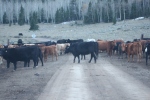 Grazing in the Intermountain West does more environmental damage than any other single activity. But ranchers have always had a choke hold on western legislators and most of the public land is grazed. One force that could overcome the ranchers grip is the market. Retirements of grazing permits (they are permits, not rights) are refered to sometimes as gold saddles. There is currently such a proposal by a legislator whose name is Adam Smith. An almost-too-perfect name for a guy coming up with an “invisible hand” market based solution. With such poetic grace on its side, the grazing retirement option may be getting a little closer. See Jodi Peterson’s article in High Country News.
Grazing in the Intermountain West does more environmental damage than any other single activity. But ranchers have always had a choke hold on western legislators and most of the public land is grazed. One force that could overcome the ranchers grip is the market. Retirements of grazing permits (they are permits, not rights) are refered to sometimes as gold saddles. There is currently such a proposal by a legislator whose name is Adam Smith. An almost-too-perfect name for a guy coming up with an “invisible hand” market based solution. With such poetic grace on its side, the grazing retirement option may be getting a little closer. See Jodi Peterson’s article in High Country News.
Category Archives: Conservation
What uses most of the land and water without showing up in production?
70% of the land in Utah is public. And 70% of that land is handed out for grazing. Over 80% of the water used in Utah is for agriculture and most of that is to grow hay for livestock. That is a lot of land and water. Open this chart on the left of the State of Utah Governor Gary R. Herbert Economic Report’s figures on employment by industry as a percent of total employment: Dec. 2011. Where’s agriculture? The subsidized use of all that land and water isn’t producing much, particularly jobs.
What does it cost to feed a gerbil for a month?
Probably more than $1.35. This is all that is charged to feed a cow AND its calf: Grazing fees on federal public lands to remain the same.
Failure of Land Use Socialism
 There is nothing more harmful to the arid lands of the American West today than public land grazing. It is ironic that the Cato Institute, the leading libertarian, conservative think tank calls the results of over a century of grazing on public lands, ” . . . a testimony to the failure of land-use socialism.” Ouch. 70% of the over 300 million acres of public land in the West is grazed, producing less than 3% of the nation’s beef. Agriculture is less than 1% of the western economies but uses nearly 80% of the water, much of that used to grow hay for to feed livestock. Ranching is a tiny little special interest. A rancher pays $1.35 per month to graze a cow and its calf. How much do you suppose it costs to feed a gerbil for a month? Yet the BLM, with $40 million of taxpayer stimulus money, wants to ignore the impact of grazing in their Rapid Ecoregional Assessments project to map ecological trends throughout the West. See more here . . . >>
There is nothing more harmful to the arid lands of the American West today than public land grazing. It is ironic that the Cato Institute, the leading libertarian, conservative think tank calls the results of over a century of grazing on public lands, ” . . . a testimony to the failure of land-use socialism.” Ouch. 70% of the over 300 million acres of public land in the West is grazed, producing less than 3% of the nation’s beef. Agriculture is less than 1% of the western economies but uses nearly 80% of the water, much of that used to grow hay for to feed livestock. Ranching is a tiny little special interest. A rancher pays $1.35 per month to graze a cow and its calf. How much do you suppose it costs to feed a gerbil for a month? Yet the BLM, with $40 million of taxpayer stimulus money, wants to ignore the impact of grazing in their Rapid Ecoregional Assessments project to map ecological trends throughout the West. See more here . . . >>
What happened to conservatives conserving?
 It seems to me the rabid right in American politics today have lost track of some of their guiding principles, some of the great virtues. Ted Williams writes in a recent blog, ” we need to grow our web of friends among those who are politically middle-of-the-road or even slightly to the right, and among those in small towns and the hinterlands. Too often we think the only field where we can gather new backers is the progressive/liberal one, but clubs such as Republicans for Environmental Protection, Backcountry Hunters and Anglers, and Trout Unlimited strongly show that there are more than a few folks caring about wild things who are not progressives, who may even be conservatives.” Ted thinks that Piety, Prudence, Posterity are principals that conservatives naturally honor, and if they applied them to how they live in place, they would find they should be, in fact and act, conservationists. . . . >>more
It seems to me the rabid right in American politics today have lost track of some of their guiding principles, some of the great virtues. Ted Williams writes in a recent blog, ” we need to grow our web of friends among those who are politically middle-of-the-road or even slightly to the right, and among those in small towns and the hinterlands. Too often we think the only field where we can gather new backers is the progressive/liberal one, but clubs such as Republicans for Environmental Protection, Backcountry Hunters and Anglers, and Trout Unlimited strongly show that there are more than a few folks caring about wild things who are not progressives, who may even be conservatives.” Ted thinks that Piety, Prudence, Posterity are principals that conservatives naturally honor, and if they applied them to how they live in place, they would find they should be, in fact and act, conservationists. . . . >>more
The Plateau as Canary
 I like this idea of Kirk Johnson’s of the Green blog at the New York Times. The fragile Colorado Plateau acting as canary in the coal mine. It doesn’t take a dust storm in Arizona to notice that the air is always hazier on the Plateau than it was even 10 years ago. So few people live on the Plateau that man made haze here is a sign of illness elsewhere. …more>>
I like this idea of Kirk Johnson’s of the Green blog at the New York Times. The fragile Colorado Plateau acting as canary in the coal mine. It doesn’t take a dust storm in Arizona to notice that the air is always hazier on the Plateau than it was even 10 years ago. So few people live on the Plateau that man made haze here is a sign of illness elsewhere. …more>>
Our River Run Dry
 The Colorado River does not make it to the sea. It’s all used up 70 miles before it gets there, leaving the Colorado River Delta parched. Over 75 percent of the water extracted goes to agriculture. Whenever something about water use comes up in the press, watering lawns always comes up. That is the wrong grass. It’s not lawns draining the river, it’s hay. Buying up the virtual property right of water rights from farmers and ranchers is called “water ranching.” I’ll try to find more on that in the future. In the meanwhile, here’s a piece from the New York Times on the river, and another interesting blog from a recent author on the subject, Jonathan Waterman (great name.)
The Colorado River does not make it to the sea. It’s all used up 70 miles before it gets there, leaving the Colorado River Delta parched. Over 75 percent of the water extracted goes to agriculture. Whenever something about water use comes up in the press, watering lawns always comes up. That is the wrong grass. It’s not lawns draining the river, it’s hay. Buying up the virtual property right of water rights from farmers and ranchers is called “water ranching.” I’ll try to find more on that in the future. In the meanwhile, here’s a piece from the New York Times on the river, and another interesting blog from a recent author on the subject, Jonathan Waterman (great name.)
Leonids Meteor Shower
 One of the hidden delights of large, underpopulated, undeveloped places is the prospect for clear dark nights, free of light pollution. The Colorado Plateau is one darkest places left in the 48 states. The Leonid meteor showers are coming up. Steve Owen of Dark Sky Diary can tell you more. . . . more>>
One of the hidden delights of large, underpopulated, undeveloped places is the prospect for clear dark nights, free of light pollution. The Colorado Plateau is one darkest places left in the 48 states. The Leonid meteor showers are coming up. Steve Owen of Dark Sky Diary can tell you more. . . . more>>
Turn of tide?
 There’s been a mounting stream of good news for the environment. 18 new wilderness zones proposed for nine Western states including three in Utah. Fabulous. Perhaps with the election year on this will be a new turn of the tide for the Obama administration? . . . more>>
There’s been a mounting stream of good news for the environment. 18 new wilderness zones proposed for nine Western states including three in Utah. Fabulous. Perhaps with the election year on this will be a new turn of the tide for the Obama administration? . . . more>>
Private Profit, Public Expense
The Salt Lake Tribune weighs in. This kind of economic nonsense of allowing an open pit coal mine on the doorstep of a favorite national park in order to create a couple hundred jobs is just what ticks off Tom Wharton in the previous post. . . . more>>

